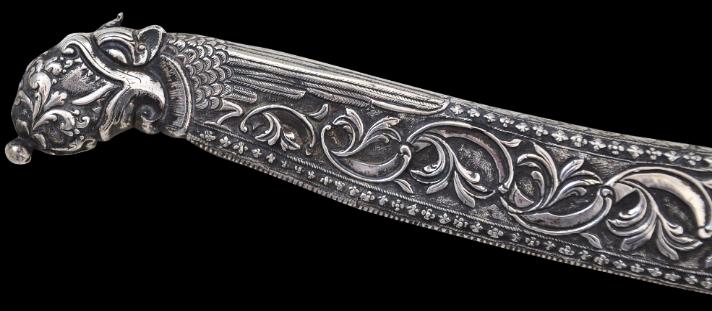
Kastane, Kasthane – Sinhalese Sri Lanka
Silver & Gilt Kasthane Sword set with Sapphires
Kandy, Sri Lanka
18th century
length: 60cm, weight: 620g
The kasthane is unique to Sri Lanka. It is a dress sword that was popular in both the central Kandy Kingdom and the low, coastal areas. Kasthanes found their way to Europe and elsewhere in the seventeenth and later centuries as highly decorative curios. Sir Alexander Popham, an English seventeenth century military figure, was painted in his equestrian portrait wearing a kasthane.
This especially fine
kasthane has a silver pommel chiselled as a typical simha (lion) head with a prominent crest made up of a parcel-gilded entwined liya-pata motif. A narrow, gilded pala-peti design is around the mouth. The gaping mouth has a small projecting tongue that points downwards and rows of pointed teeth. The snout on each side has a characteristic ‘S’ scroll. The eyes are large and distinct and comprise blue sapphires in gilded or gold mounts and with scrolled eyebrows. The ears are prominent and in leaf form.
The
simha’s main comprises a series of semi-circular whirls on top and a spectacular array of whirls about the neck with parcel-gilding. The grip is almost octagonal; the ventral surface with prominent finger grooves. It is also embossed with columns of liya pata and with parcel gilding.
The narrow crossguard in two
serapendiya head quillon finials. An ‘S’-shaped knuckle guard issues from the mouth one and this guard terminates in a serapendiya head with a flat, gilded, floral scroll that emits from its mouth and which does not quite join with its neck. The outward face of the knuckle guard is further decorated with a cross-legged nari-lata figure, seated amid flowing foliage. A pair of finger-rings which also terminate with serapendiya heads are joined at their backs to the two quillons.
The ricasso at the root of the blade is encased in silver sheet engraved with the
sinha flower motif within a scrolling trellis design. The langet is chased with a stylised mask motif.
The blade, of steel, is single edged and curved. It finished with a point. It has a short fuller. Possibly, the blade is of European manufacture; usually the blades of kasthanes are.
The scabbard is as fine and in terms of silversmithing work, is as spectacular as the hilt. It is curved and chased or repoussed with rococo-esque scrolling floral and foliage patterns against a finely tooled ground. The scabbard is held together by the locket and another plain silver band. Two silver carrying rings are attached to the top of the locket. The chape is in the form of a
serapendiya head disgorging a floral sphere which itself terminates with a plain silver bead.
The form and motifs employed on the hilt and scabbard are very similar to a
kasthane in the National Museum in Colombo (illustrated in De Silva & Wickramasinghe, 2006, p. 152).
References
Caravana, J. et al, Rites of Power: Oriental Weapons: Collection of Jorge Caravana, Caleidoscopio, 2010.
Coomaraswamy, A.K.,
Mediaeval Sinhalese Art, Pantheon Books, 1956 reprint of the 1908 edition.
De Silva, P.H.D.H & S. Wickramasinghe,
Ancient Swords, Daggers & Knives in Sri Lankan Museums, Sri Lanka National Museums, 2006.
Weereratne, N.,
Visions of an Island: Rare works from Sri Lanka in the Christopher Ondaatje Collection, Harper Collins, 1999.
Provenance
UK art market
Inventory no.: 1277
SOLD










